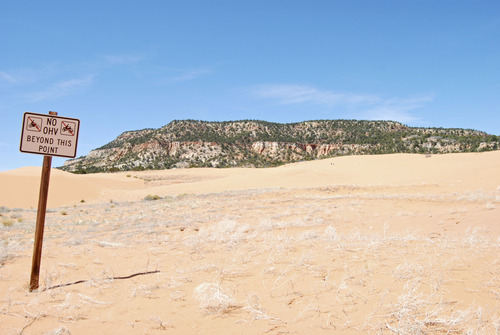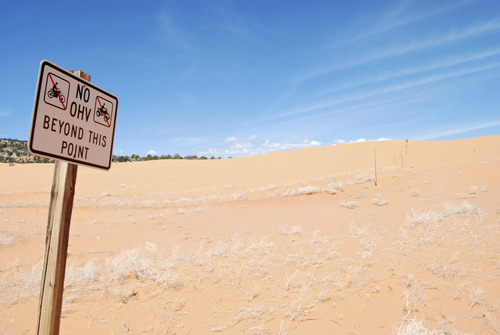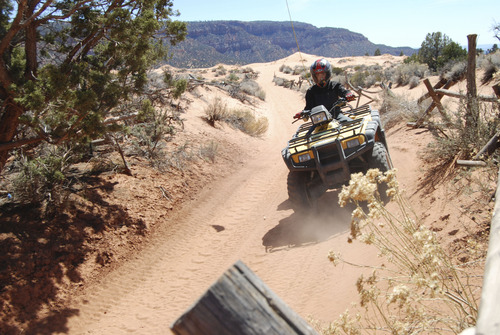This is an archived article that was published on sltrib.com in 2013, and information in the article may be outdated. It is provided only for personal research purposes and may not be reprinted.
State and federal officials are expanding conservation zones in the Coral Pink Sand Dunes to further protect a rare beetle, narrowing the portion of the dunes available to off-road vehicles.
Announced Friday, the move is hoped to secure additional habitat for the Coral Pink Sand Dunes tiger beetle, which the U.S. Fish and Wildlife Service has proposed for protection under the Endangered Species Act.
The agency is to decide by the end of September whether to list the beetle as threatened. Such a listing would designate the northern two-thirds of the dunes as critical habitat for the beetle and exclude ATVs from what has been a popular motorized playground for years, including much of Coral Pink Sand Dunes State Park.
These machines, along with climate change, pose the biggest threat to this insect, according to Paul Abate, a supervisory biologist with the service's Utah office.
"Extensive ATV use and tiger beetles aren't really compatible," Abate said. "It churns up sand the beetle uses for burrowing habitat. It dries it up."
This is important because the sand must retain a certain amount of moisture for beetles to lay and hatch eggs and larvae to thrive. Motorized wheels also wreck the vegetation that the beetles' prey species, such as ants, need for food and shelter.
Federal authorities are proposing to designate 2,276 acres as critical habitat for the beetles, most of it administered by the Bureau of Land Management. The designation, which would take effect if the tiger beetle is listed as endangered, also covers Coral Pink Sand Dunes State Park's northern half. Park supervisors are worried that the off-roading experience will no longer be enjoyable if riding is confined to the southern tip of the dunes.
"We want to avoid a listing if at all possible," said Kane County Commissioner Jim Matson, who endorses the revisions to the conservation plan. "Our goal is to keep that park open. It's a factor in our local economy and we want to make sure we are doing the right thing for the habitat."
Currently, there are two conservation areas in the dunes separated by a couple miles. Under the revised conservation plan, the southern area will be expanded from 205 to 266 acres, and 14 patches, totaling another 263 acres, will be set aside to ensure a chain of habitat between the two conservation areas. This move will increase the amount of occupied habitat that is protected from 48 to 88 percent, Abate said.
"If you can expand their core population area, that would allow that population to sustain itself in the future and better deal with climate change and drought," Abate said. "Connecting the two conservation areas and protecting that habitat will allow beetles to disperse from one area to the other and establish more habitat for the beetle to colonize."
In recent years, the beetles' population count has hovered between 1,100 and 1,500, according to entomologist Barry Knisley, who conducts a population survey at the dunes every May.
This species is just one of more than 100 tiger beetles species in North America and it is found nowhere else, probably because it is uniquely adapted to the Coral Pink Sand Dunes' distinct environment, said Knisley, an emeritus biology professor at Virginia's Randolph-Macon College.
The BLM will install a weather-monitoring station to record data that will inform an adaptive management process. The goal is to track how well the conservation plan is working and make adjustments.
If the plan demonstrates it is helping the beetle recover, the chances of an endangered listing would diminish, Abate said.
A federal economic impact study tried to quantify the proposed listing's hit on the motorized recreation economy, but concluded that available visitation data were not adequate to draw conclusions. The study did conclude the park generates $700,000 to $800,000 in economic activity. This represents about one-fifth of 1 percent of Kane County's economy.
Federal officials have proposed listing this rare insect, found only in its namesake dunes in Kane County, as a threatened species. The listing could close much of the Coral Pink Sand Dunes State Park to motorized recreation. The U.S. Fish and Wildlife Service is hosting an event May 22 at the Kanab Public Library, 374 N. Main, to inform the public about the proposed listing and take comment. The information meeting runs from 4 to 6 p.m. followed by a public hearing from 7 to 9 p.m.







